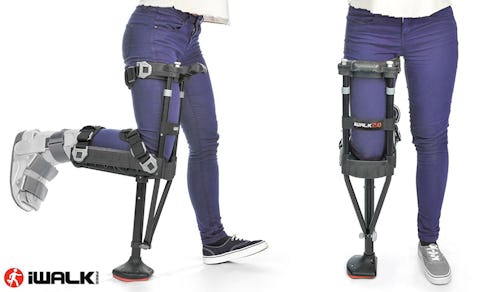Life
Someone Invented A Crutch You Can Use Hands-Free & It's A Game Changer For Leg Injuries
Crutches haven’t changed much in design since they were first made commercially available over 100 years ago. Your standard pair of crutches relies primarily on underarm support, adding extra discomfort to your armpits as well as restricting your hands and arms from doing daily tasks. However, this hands-free crutch is hoping to make recovering from an injury more painless and leave your arms and hands free to use.
The iWalk 2.0 is a crutch that attaches directly to the leg in recovery, allowing you to keep your arms and hands free. The crutch straps onto your upper thigh, resting your leg in a bent, 90 degree angle on a cushioned pad. Rather than requiring extra strain on your underarms, it transfers the weight to your leg. This particular point of innovation is what the iWalk 2.0 manufacturer says sets their crutch apart.
On regular crutches, you can’t easily navigate stairs and activities like grocery shopping, walking your dog, or even carrying a drink while you walk are difficult if not impossible to do. Even newer crutch alternatives like knee scooters don’t leave your hands free and still leave you unable to do certain daily activities, like pushing a shopping cart. The iWalk 2.0 not only frees your arms and hands, it keeps your upper body from the strain and, often, bruising associated with standard crutches. In other words, this new hands-free crutch doesn’t add extra pain to your recovery process and allows you to stay mobile even with a leg injury.
While the iWalk 2.0 crutch is adjustable for height, it does have some size requirements. It can accommodate users who are between 4’10” and 6’6” tall and weight 275 lbs or under. There are also some mobility specifications you must meet in order for the iWalk 2.0 to be effect. If balancing on one leg or walking up and down stairs were difficult prior to your injury, this hands-free crutch might not be best for your recovery needs.
As a video from Tech Insider specifies, the iWalk 2.0 is designed for “non-weight bearing lower leg injuries.” This new crutch is really only effective for injuries that fall below the knee. Since it’s transferring your weight from your underarms to your upper thigh and knee, the iWalk 2.0 is most effective for ankle foot injuries. You also must be able to bend your injured leg 90 degrees and have full mobility in your non-injured leg.
The iWalk 2.0 currently retails starting at $149 and is available for purchase on Amazon and Walmart.com.
Many Twitter users seem excited by the new crutch innovation, sharing how they wish they’d had this crutch during their recovery. However, some of the initial review of the crutch are mixed. “My dad got this when he broke a bone in his foot and he said it actually hurt his knee more than it actually helped,” one Twitter user shared.
Christopher Null wrote an extensive review of the iWalk 2.0 for Wired after he used the crutch while recovering from a foot fracture. After some practice, Null said he was able to get in and out of the crutch in about 15 seconds, relatively close to the 10 seconds the iWalk site claims. One upside to standard crutches is there’s little to no assembly required. While the iWalk 2.0 didn’t make other crutches obsolete —Null says quick trips to answer the doorbell were best done with a knee scooter and crutches were necessary to get out of bed—he did end up using it for pretty much everything else. As Null put it, “I’ve never loved a product so much while wanting nothing more than to never have to use it again.”
The iWalk 2.0 joins the ranks of other innovative crutch substitutes like The Clutch Crutch created by students at Purdue University and the M+D crutch, which cradles the upper arm. If anything, the iWalk 2.0 and its brethren are proof that we are long overdue for an affordable, accessible alternative to the standard set of crutches.
